What is it about chub? One minute they can be throwing themselves on the bank and the next they can be as tricky as and as cunning as, well… as a chub!
There are so many ways to fish for them and yet none seem immune from the innate natural caution of the fish. There are, however, some caveats to this particularly when really big chub are the quarry and by really big I’m referring to fish of 6lb and above which are my target from the sections of the River Lea that I fish.
The Lea comprises three distinctly different water profiles: the river, the Navigation and the Flood Relief Channel and each of them hold huge chub, to well over 8lb. On each of the venues the standard ground rules apply for location, well…in general terms at least. Obvious features such as overhanging trees, moored boats, weed-lined gravel runs, drop-offs or margin shelf bases are the primary areas. Some of these swims are holding stations where you can usually find a chub or two in residence at most times, others are patrol routes which a fish, or groups of fish, will pass through at some time or other.
Through fishing the Navigation a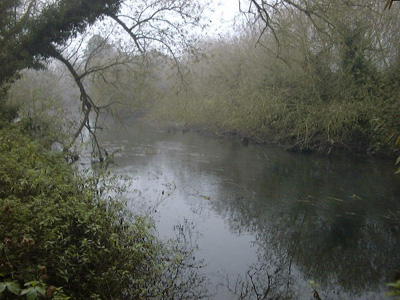 nd Relief Channel, I’ve found that the chub do tend to drop down to the slower, deeper areas and spread out more when the autumn starts, preferring the shallower, better oxygenated water of the weirs and river through the summer.
nd Relief Channel, I’ve found that the chub do tend to drop down to the slower, deeper areas and spread out more when the autumn starts, preferring the shallower, better oxygenated water of the weirs and river through the summer.
Since I run my own business much of my fishing is done in the evenings and most helpfully the chub tend to be more mobile and far less spooky from dusk onwards. I also look to the longer nights of autumn and winter for the prime time to target them when they’re in peak condition and at their top weights for the season.
When I started my chub fishing ten years ago I used a mixture of quiver tips and bobbins, depending on the bait I was using and the conditions I was faced with at the time. Bread, lobs, cheesepaste and maggots all caught their share of good fish, although the number of missed bites was frustrating… you know, that lightening fast crack on the rod tip which you never get anywhere close to reaching! Given the stamp of fish in the river some of these missed bites were almost certainly from very big fish and it quickly dawned on me that there just had to be another way!
I’m well aware that there are many anglers who feel that the ‘strike’ is an integral part of the skill and challenge of angling however, as far as chub are concerned, my experience is that it’s really just a physical test of how fast you can react and I go fishing to catch fish – not to test my reaction time. If my rig can do that for me, I’m one step closer to banking that fish.
Enter the world of carp fishing.
Switching to boilies and semi-fixed bolt rigs has largely seen the end of all of my frustration. Whilst it’s true that occasionally a chub will seemingly try to strip off the bait (and I’ve had quivertip rods pulled off the rests when they’ve tried it) they will usually return whether they succeed or not.
 One of the main advantages of this method and bait is that it can be applied whatever the conditions from slow and clear water right through to full-on flood and interestingly -contrary to just about every book and feature – I’ve caught some of my best chub on rising floodwaters and with a single hook bait.
One of the main advantages of this method and bait is that it can be applied whatever the conditions from slow and clear water right through to full-on flood and interestingly -contrary to just about every book and feature – I’ve caught some of my best chub on rising floodwaters and with a single hook bait.
As far as tactics are concerned wherever I am I usually try and fish a rod length out from whichever is the most likely margin (preferably the nearer) and my other rod goes in the middle; either in the flow if it’s slow, or, on the crease if it’s pushing through and this applies whatever the conditions. Although the surface current may appear fast in a flood it isn’t anything like as fast on the bottom due to depth and friction effects and I can be confident that a single boilie will stay on, crayfish permitting, for the duration of my session. Back leading to drop the line out of the current and away from fish movement is a must too as these fish are pressured and will spook if they touch line.
Where permitted I try and fish to midnight since the first half of the night is when I’ve found it to be most productive.
The biggest chub are either solitary or in groups of two or three at most so I don’t put out a lot of bait on my sessions. A stringer or a small PVA bag of a few broken boilies is fine with a re-cast every hour and I will use up to a dozen free offerings around each bait. Hourly bait checking is a must since the crayfish will only back off when there are fish in the vicinity. Under these circumstances the more traditional baits: bread, worms, cheese etc are gone in 10 minutes and there is no doubt that boilies have the best longevity of all, especially where there are no competing shoals of fish to keep the crayfish at bay.
The flavour of boilies is largely irrelevant I think (they’ll take savoury and sweet alike) so long as the bait is of good quality. I tend to prefer softer baits as the leakage of flavour is increased and I’ve found that popular to common belief hardened boilies do not actually defeat the crayfish.
Having recognised the chubs’ nocturnal mobility I’m happy to remain in a swim for the whole session and can see no real advantage in being mobile myself. I’ve had bites within a few minutes of casting out or up to 7 hours later with multiple captures of up to four fish in an evening. If the feature is right I know from experience that they’ll likely be through at some point during the night.
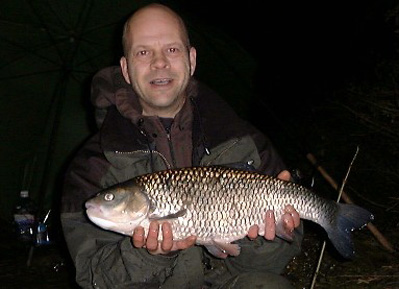
I keep my set-up simple. Avon rods, 10lb main line, a 6 to 8 inch coated braid hooklength to prevent tangles, 2 or 3oz Grippa Leads on a safety lead-clip (weight depending on conditions) and circle hooks with the barb partially crushed or fished line-aligner style on other patterns.
My use of circle hooks raise a few eyebrows occasionally; the advantage of them is that they are specifically designed for self-hooking rigs and for catching the lip of the fish – they are also extremely sharp but to be effective they should never be totally barbless – crushed barbs at most.
The shape of Grippa Leads adds plenty of resistance on the take and thus aids the bolt effect by making sure the hook pricks the fish; it’s also a very useful shape to mould some paste around to enhance or create an attractive scent trail.
Hair length has largely become irrelevant to my chubbing since I’ve found – again contrary to most opinion – that long and short hairs work equally well. I start with short and may change according to the fish’s response but it is now a very rare occurrence to lose fish once they have the hook in their mouth.
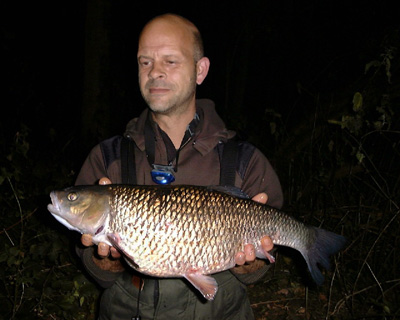 For back leading I used a coffin lead held about 4 feet up the line by a float stop in the past but I have now switched to clip-on captive back-leads as they give more flexibility with adjusting weight and where I want the back-lead to sit – which may sometimes be virtually under my rod tip.
For back leading I used a coffin lead held about 4 feet up the line by a float stop in the past but I have now switched to clip-on captive back-leads as they give more flexibility with adjusting weight and where I want the back-lead to sit – which may sometimes be virtually under my rod tip.
Average expectations are one or two bites in a good session so in the freezing depths of winter a Baitrunner with alarms gives some welcome freedom to clutch a hand-warmer or boil the kettle at regular intervals. It also helps when the odd nuisance barbel or carp puts in an appearance!
Recalling the 6 and 7 pounders that I’ve caught over the years I couldn’t honestly put my finger on any one set of conditions that has stood out over and above any other. I’ve caught big fish in everything from freezing, frosty, clear skies to snow; in clear water, and in murky floodwater; I’ve caught them when it’s been fining down, mild, windy and in still conditions and rain.
As far as bites are concerned I’ve had sail away runs that I thought were barbel and, during an experimental phase of using pop-ups at Carthagena Navigation, a single bleep and the slightest nodding on the rod tip yielded a 7lb 7oz specimen.
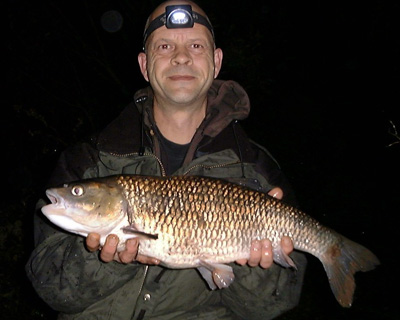 One of the most important keys to success with the biggest of chub is, of course, time. Locating a handful of chub in the canalised stretches (usually 7 to 8ft deep with zero visibility) can be tricky and there are many blank nights to be endured particularly whilst working out the best swims. The more time on the bank, the more you learn, the more likelihood of reward.
One of the most important keys to success with the biggest of chub is, of course, time. Locating a handful of chub in the canalised stretches (usually 7 to 8ft deep with zero visibility) can be tricky and there are many blank nights to be endured particularly whilst working out the best swims. The more time on the bank, the more you learn, the more likelihood of reward.
Over the years I’ve fished with a number of different friends and have tried different methods during the course of campaigns with them. Bob Hornegold had particular success with the bolt rigged maggot feeder several seasons ago and caught a huge number of fish on it including a good number of 6lb fish.
This all started some years back with his then fishing partner, Gary Newlands, who refined Bob’s design for in-line heavy feeders for use in what became known as the ‘Gallon O’ Maggot attack’. Gary and Bob have had some incredible catches where it was not uncommon to catch 10lb of dace before progressively larger chub moved in and finally even large barbel. Starting off with a 36in hooklength you invariably end up with one of 2in as the big fish try to make off with the feeder! It’s hard work and not a cheap method these days but its effectiveness is unrivalled where there’s a good head of fish.
As far as other fishing friends are concerned Tony Gibson finally managed to break the 7lb chub barrier with boilies at Carthagena Weir where we worked together on the most productive swims throughout the winter a few years ago. I did evenings and he did overnighters but he didn’t find much action past midnight, although we both caught many chub to over 7lb.
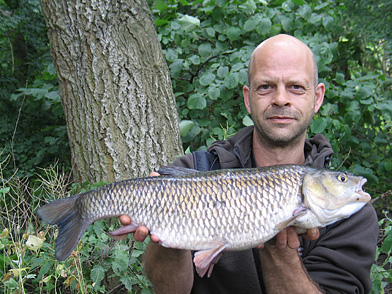 Being a member of the Osprey Specimen Group during this time has also helped in many ways. Not only in having others to bounce ideas off, particularly in a run of blanks when your confidence can take a few knocks, but also in helping others too. Several Osprey members have joined in the winter fun for a big Lea Chub and almost all have benefited with a new personal best in the 6 to 7lb range at the end of it. Swapping current information on catches, blanks, bait and conditions enhances everyone’s experience and makes it feel like a real “team” effort.
Being a member of the Osprey Specimen Group during this time has also helped in many ways. Not only in having others to bounce ideas off, particularly in a run of blanks when your confidence can take a few knocks, but also in helping others too. Several Osprey members have joined in the winter fun for a big Lea Chub and almost all have benefited with a new personal best in the 6 to 7lb range at the end of it. Swapping current information on catches, blanks, bait and conditions enhances everyone’s experience and makes it feel like a real “team” effort.
To sum up the boilies and bolt-rig approach has certainly sorted out the better specimens for me and whilst it’s not for me to say that other methods and baits wouldn’t have worked just as well it certainly has its advantages when you are faced with low stock density fish, crayfish and missed bites –the scenario that otherwise conspires against consistent success on the Lea and, I am sure, on many other river systems too.
Simon King










